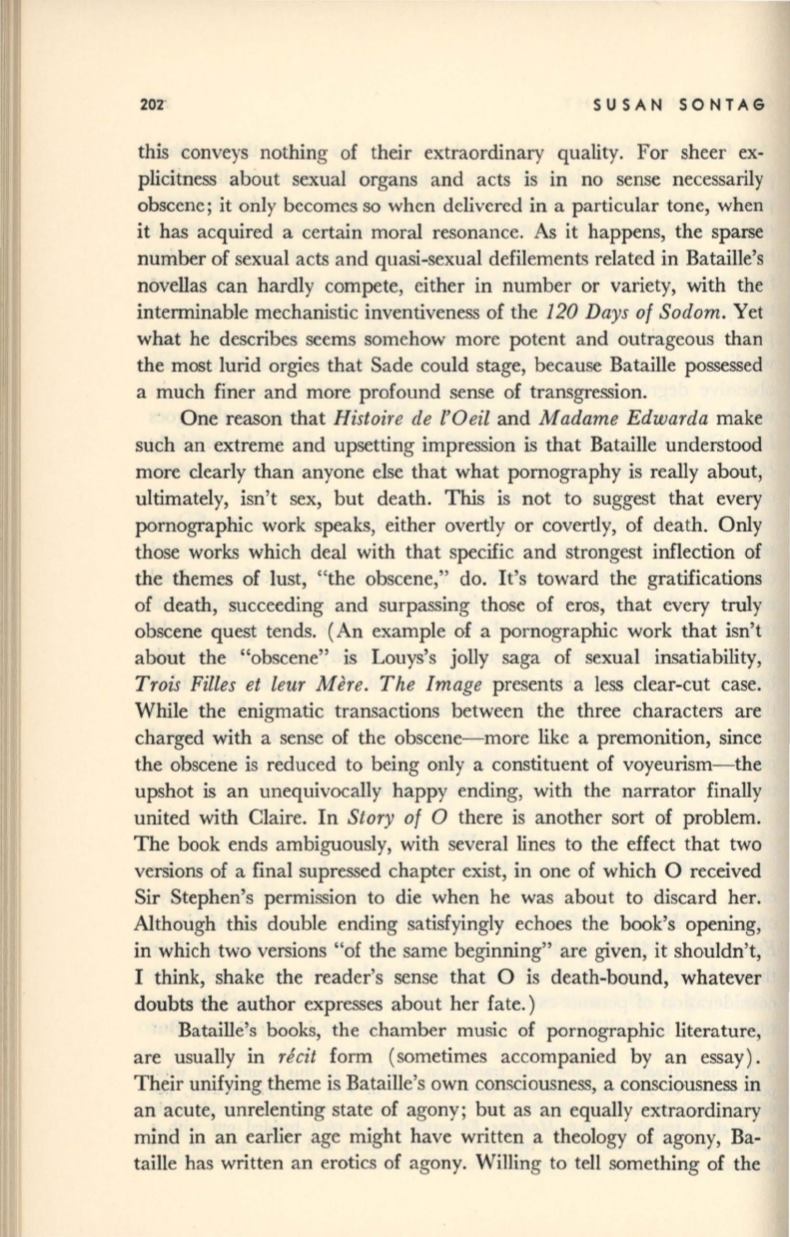
202'
SUSAN SONTAG
this conveys nothing of their extraordinary quality. For sheer ex–
plicitness about sexual organs and acts is in no sense necessarily
obscene; it only becomes so when delivered in a particular tone, when
it has acquired a certain moral resonance. As it happens, the sparse
number of sexual acts and quasi-sexual defilements related in Bataille's
novellas can hardly compete, either in number or variety, with the
interminable mechanistic inventiveness of the
120 Days of Sodom.
Yet
what he describes seems somehow more potent and outrageous than
the most lurid orgies that Sade could stage, because Bataille possessed
a much finer and more profound sense of transgression.
One reason that
Histoire de l'Oeil
and
Madame Edwarda
make
such an extreme and upsetting impression is that Bataille understood
more clearly than anyone else that what pornography is really about,
ultimately, isn't sex, but death. This is not to suggest that every
pornographic work speaks, either overtly or covertly, of death. Only
those works which deal with that specific and strongest inflection of
the themes of lust, "the obscene," do. It's toward the gratifications
of death, succeeding and surpassing those of eros, that every truly
obscene quest tends. (An example of a pornographic work that isn't
about the "obscene" is Louys's jolly saga of sexual insatiability,
Trois FiZZes et leur Mere. The Image
presents a less clear-cut case.
While the enigmatic transactions between the three characters are
charged with a sense of the obscene- more like a premonition, since
the obscene is reduced to being only a constituent of voyeurism-the
upshot is an unequivocally happy ending, with the narrator finally
united with Claire. In
Story of
0 there is another sort of problem.
The book ends ambiguously, with several lines to the effect that two
versions of a final supressed chapter exist, in one of which 0 received
Sir Stephen's permission to die when he was about to discard her.
Although this double ending satisfyingly echoes the book's opening,
in which two versions "of the same beginning" are given, it shouldn't,
I think, shake the reader's sense that 0 is death-bound, whatever
doubts the author expresses about her fate.)
Bataille's books, the chamber music of pornographic literature,
are usually in
recit
form (sometimes accompanied by an essay).
Their unifying theme is Bataille's own consciousness, a consciousness in
an acute, unrelenting state of agony; but as an equally extraordinary
mind in an earlier age might have written a theology of agony, Ba–
taille has written an erotics of agony. Willing to tell something of the


